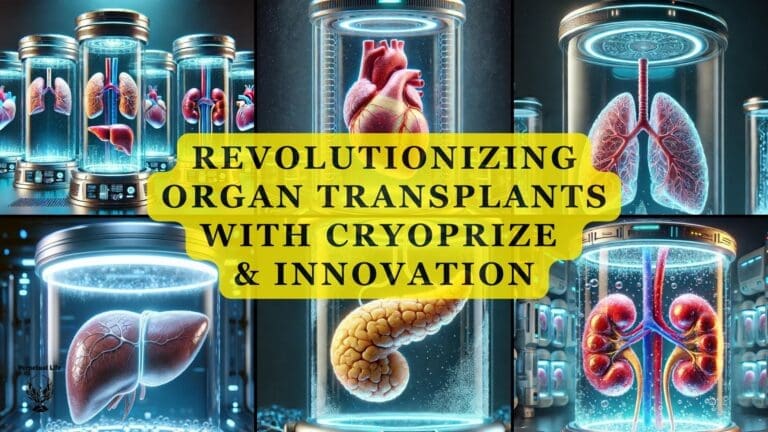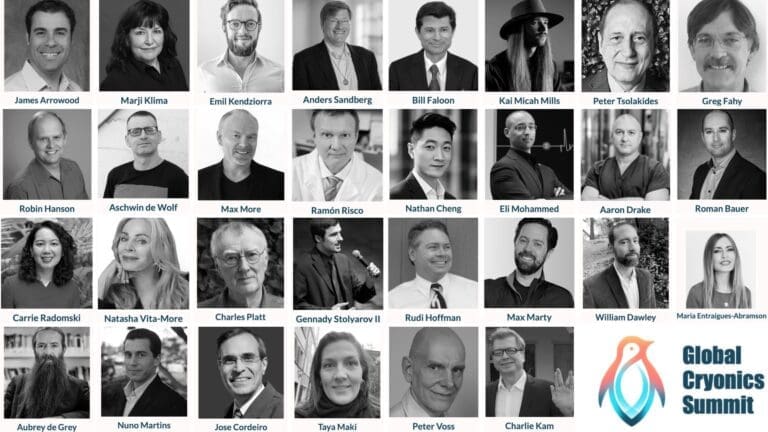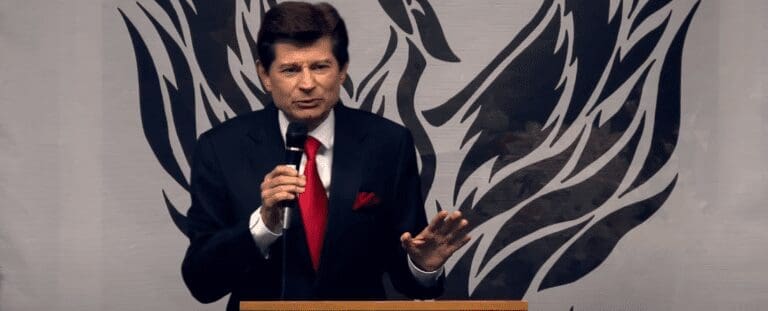In November 2023, the Church of Perpetual Life celebrated its 10-year anniversary with a grand event that was live-streamed globally. Featuring visionary speakers like Bill Faloon and Max More, the event explored the cutting-edge advancements in longevity science, transhumanism, and the practical steps we can take today to extend human lifespans. This momentous occasion symbolized the growing media interest and scientific breakthroughs that have made human immortality more than just a distant dream.
As cellular reprogramming, cryonics, and gene-editing technologies continue to gain ground, more people are asking: Can we truly reverse aging and live forever? This blog delves into the highlights from the celebration, exploring how scientific advancements and mainstream attention are accelerating the path toward life extension.
Watch the full 10-Year Anniversary Celebration:
Summary
- 🎉 Celebration of 10 Years of Church of Perpetual Life : A transhumanist church dedicated to achieving eternal life through science and technology.
- 🌱 Mission of the Church: To extend human lifespan by harnessing modern advancements in technology and health.
- 💬 Speakers: Bill Faloon shared practical health tips for longevity, and Max More discussed cryonics as a life extension strategy.
- 🔬 Advancements in Longevity Science: Technologies such as CRISPR, cellular reprogramming, and stem cell therapy were presented as key to reversing aging.
- 📈 Media Coverage: Increasing public and media interest in immortality from outlets like The Economist and National Geographic was highlighted.
- 💉 Health Recommendations: Bill Faloon emphasized the importance of diet, exercise, and stress management in extending life.
Key Advancements in Longevity Science
The discussions during the Perpetual Life Church event centered around some of the most exciting advancements in longevity science. Bill Faloon and Max More highlighted several critical technologies that have fueled the media’s growing interest in immortality:
- CRISPR Gene Editing and Reversing Aging
One of the most revolutionary breakthroughs is CRISPR, a gene-editing technology that has been discussed in outlets like The Economist and The Wall Street Journal. This tool allows scientists to edit genetic codes, potentially halting or reversing the aging process in humans. According to George Church, a Harvard professor featured in the event, this technology could soon be used to cure aging, bringing us closer to life extension. - Cellular Reprogramming Through Yamanaka Factors
Cellular reprogramming, particularly through Yamanaka transcription factors, is another area showing significant promise. This technique has already reversed aging in animal models, rejuvenating their cells and tissues. Although further research is needed, the early successes of this technology are driving excitement in the scientific community and beyond. - Cryonics: A Practical Life Extension Strategy
Max More underscored the importance of cryonics as a core strategy in the quest for immortality. Cryonics involves preserving individuals at sub-zero temperatures after death, with the hope that future technologies will revive them and restore their health. It serves as a practical backup plan, ensuring that individuals have the opportunity to benefit from future medical advancements even if current technologies are unable to save them today.
How Media Coverage is Shifting Perspectives on Immortality
In the past, topics like human immortality and reversing aging were often confined to science fiction or fringe scientific circles. Today, they are becoming mainstream, thanks in large part to significant media coverage from influential publications such as National Geographic and Wired Magazine. These outlets are increasingly featuring articles about longevity research and the potential for life extension technologies, leading to greater public awareness and interest.
In 2023 alone, major headlines have focused on scientific breakthroughs that could potentially slow or even stop the aging process. This shift in media coverage is making people more open to the idea of living longer, healthier lives, and it is no longer considered purely speculative.
Practical Steps for Living Longer Today
During the anniversary event, Bill Faloon shared practical insights for individuals seeking to extend their lives now, before futuristic technologies become widely available. These health recommendations include:
- Avoid Processed Foods: Faloon emphasized the importance of avoiding ultra-processed foods, which have been linked to numerous age-related diseases.
- Physical Activity: Engaging in regular exercise and maintaining an active lifestyle can have a significant impact on longevity.
- Stress Management: Chronic stress has been shown to accelerate aging, so finding ways to reduce stress is essential for anyone interested in living a long, healthy life.
The Future of Longevity Research
As longevity science continues to progress, the potential for human immortality becomes more realistic. Scientists are developing biotechnology to reverse aging, regenerate tissues, and restore health. According to speakers at the Perpetual Life Church anniversary, technologies like stem cell therapy and organ regeneration are key areas to watch as we move closer to achieving longevity escape velocity, the point at which human lifespan may be extended indefinitely.
Investments in research from governments and private entities are increasing, including Saudi Arabia’s pledge to spend $1 billion per year to combat aging. This shows that the quest for immortality is not just a personal dream but a global priority, with resources being funneled into finding solutions to extend human life.
Conclusion Diagram:

Insights Based on Numbers
- 15 to 25 years: Bill Faloon suggested that making healthy lifestyle changes could extend life spans by 15 to 25 years, illustrating the practical benefits of current health choices.
- 25,000: The number of people in South Florida supporting life extension groups, showcasing growing interest in longevity.
- 132,000: Square footage of the new Church headquarters, reflecting the expanding scale of the Church of Perpetual Life.
Here are 20 relevant timestamps from the video “Perpetual Life 10 Year Anniversary Celebration!” based on the provided captions:
- Welcome to the Church of Perpetual Life: 00:00:31
- Our Creed is sacred life and unlimited lifespan: 00:01:04
- Transhumanist church with diverse members: 00:01:34
- First-time attendees at the event: 00:02:06
- Story about a Hollywood church location: 00:02:37
- Strange story about headless chickens: 00:03:09
- An offer to leave estate to the church: 00:03:40
- Event disrupted by a woman during donation: 00:04:10
- Longevity Festival: A celebration of life: 00:05:12
- Introduction to cryonics and life extension: 00:05:43
- Cryonics presentation scheduled for December: 00:06:15
- The founding of the church and its early challenges: 00:08:22
- Relocation due to church growth: 00:09:24
- Aubrey de Grey’s role in finding the church leader: 00:09:56
- Introduction to the second church and its larger space: 00:10:58
- Increasing media attention on longevity science: 00:14:09
- The Economist features human immortality: 00:15:11
- Research on young blood’s anti-aging effects: 00:15:42
- Cellular reprogramming to reverse aging: 00:17:15
- JP Morgan’s seminar on longevity for wealthy clients: 00:18:17
These timestamps link directly to the specific moments in the video, providing a way to easily navigate the important points discussed.
Explanatory Q&A
Q1: How does the Church of Perpetual Life integrate various religious beliefs into its mission for longevity?
The Church of Perpetual Life is described as a “transhumanist” church that is not based on any one particular religion. Its members come from a variety of faith backgrounds, including Christianity, Judaism, Buddhism, atheism, and agnosticism. Despite these differences, the Church brings them together around a shared goal: the desire to live an infinite lifespan. The focus is not on religious dogma but on the broader mission of using science and technology to extend life indefinitely. The Church encourages a vision of creating a “heaven on Earth,” where eternal life, perfect health, and joy are achievable through human effort and scientific advancement.
In this way, the Church accommodates a diverse range of spiritual beliefs while uniting members through a common purpose of pursuing longevity and immortality.
Q2: What scientific advancements have contributed most to the growing media interest in immortality?
The video emphasizes several key scientific advancements that have played a significant role in increasing media attention around the concept of immortality. One major development is the CRISPR gene-editing technology, highlighted by Harvard professor George Church, which holds potential to reverse aging at a cellular level. This technology is one of many breakthroughs that have sparked serious conversations in mainstream outlets about extending human lifespan.
Another critical advancement discussed is cellular reprogramming, particularly through Yamanaka transcription factors, which have shown the ability to reverse aging in animal models. The rapid progress in stem cell research, cryonics, and organ regeneration also attracts significant media interest, as they represent tangible steps toward the possibility of human immortality.
Publications like The Economist and The Wall Street Journal have increasingly reported on these advancements, shifting the conversation from speculative science to serious, funded research projects, including longevity clinics and the involvement of influential scientists and tech leaders. The possibility of reversing aging and extending life indefinitely is no longer confined to fringe groups but has become a mainstream discussion.
Q3: How does cryonics serve as a practical option for life extension?
In the video, Max More, a leading transhumanist and cryonics advocate, emphasizes that cryonics should be considered a primary strategy, rather than just a backup plan, for life extension. He presents cryonics as an extension of emergency medicine, where instead of accepting death, we preserve the body (or brain) at very low temperatures to halt biological deterioration until future technologies can potentially revive and heal the individual.
Cryonics is portrayed as a practical option because it allows people to “pause” the dying process in situations where today’s medical technologies can’t save them. By preserving the brain’s essential structures, future advancements, such as cellular repair and rejuvenation, could potentially restore life. More argues that, although medical advances like longevity escape velocity might help prevent death from aging in the future, accidents and sudden illnesses can still occur, making cryonics a valuable contingency plan.
He also highlights that cryonics is affordable for many through life insurance, which can be used to cover the costs of the process, making it a realistic option for those interested in long-term life extension.
Conclusion: Join the Journey Toward Immortality
As the Church of Perpetual Life enters its second decade, the progress made in life extension technologies is undeniable. With breakthroughs in CRISPR, cellular reprogramming, and cryonics, humanity is on the brink of a new era where aging could become a thing of the past. As Bill Faloon and Max More have shown, achieving immortality is no longer a question of “if,” but “when.”
“Death is optional,” said Faloon, summarizing the core message of the event. “We just need to live long enough to take advantage of the technological advances on the horizon.”
If you’re interested in living a longer, healthier life and being part of the longevity revolution, now is the time to start. Explore the latest research, stay informed, and take practical steps to improve your health today.
Join the movement towards a future without death.
Check out the Mind Map of The Future of Immortality: Highlights from Perpetual Life’s 10 Year Anniversary Celebration!

*Disclaimer: Youtube video summary of live stream on Nov 16, 2023 | 10 Year Anniversary Celebration with presentations by Bill Faloon & Max More. This summary/ long form blog was created with the assistance of AI language model ChatGPT by OpenAI.





